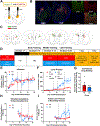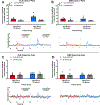Changes in dorsomedial striatum activity during expression of goal-directed vs. habit-like cue-induced cocaine seeking
- PMID: 38957402
- PMCID: PMC11218864
- DOI: 10.1016/j.addicn.2024.100149
Changes in dorsomedial striatum activity during expression of goal-directed vs. habit-like cue-induced cocaine seeking
Abstract
A preclinical model of cue exposure therapy, cue extinction, reduces cue-induced cocaine seeking that is goal-directed but not habit-like. Goal-directed and habitual behaviors differentially rely on the dorsomedial striatum (DMS) and dorsolateral striatum (DLS), but the effects of cue extinction on dorsal striatal responses to cue-induced drug seeking are unknown. We used fiber photometry in rats trained to self-administer cocaine paired with an audiovisual cue to examine how dorsal striatal intracellular calcium and extracellular dopamine activity differs between goal-directed and habit-like cue-induced cocaine seeking and how it is impacted by cue extinction. After minimal fixed-ratio training, rats showed enhanced DMS and DLS calcium responses to cue-reinforced compared to unreinforced lever presses. After rats were trained on goal-promoting fixed ratio schedules or habit-promoting second-order schedules of reinforcement, different patterns of dorsal striatal calcium and dopamine responses to cue-reinforced lever presses emerged. Rats trained on habit-promoting second-order schedules showed reduced DMS calcium responses and enhanced DLS dopamine responses to cue-reinforced lever presses. Cue extinction reduced calcium responses during subsequent drug seeking in the DMS, but not in the DLS. Therefore, cue extinction may reduce goal-directed behavior through its effects on the DMS, whereas habit-like behavior and the DLS are unaffected.
Keywords: Cocaine; Cue extinction; Dopamine; Dorsal striatum; Goal-directed; habit.
Conflict of interest statement
Declaration of competing interest The authors declare that they have no conflict of interest.
Figures





Update of
-
Changes in dorsomedial striatum activity mediate expression of goal-directed vs. habit-like cue-induced cocaine seeking.bioRxiv [Preprint]. 2023 Jul 26:2023.07.24.550364. doi: 10.1101/2023.07.24.550364. bioRxiv. 2023. Update in: Addict Neurosci. 2024 Jun;11:100149. doi: 10.1016/j.addicn.2024.100149. PMID: 37546826 Free PMC article. Updated. Preprint.
References
-
- Carter BL, Tiffany ST, Meta-analysis of cue-reactivity in addiction research, Addiction 94 (1999) 327–340. http://www.ncbi.nlm.nih.gov/pubmed/10605857. accessed May 8, 2019. - PubMed
-
- Milton AL, Everitt BJ, The persistence of maladaptive memory: addiction, drug memories and anti-relapse treatments, Neurosci. Biobehav. Rev 36 (2012) 1119–1139. http://www.ncbi.nlm.nih.gov/pubmed/22285426. accessed November 9, 2018. - PubMed
-
- Wang GJ, Volkow ND, Fowler JS, Cervany P, Hitzemann RJ, Pappas NR, Wong CT, Felder C, Regional brain metabolic activation during craving elicited by recall of previous drug experiences, Life Sci. 64 (1999) 775–784. http://www.ncbi.nlm.nih.gov/pubmed/10075110. accessed June 20, 2019. - PubMed
Grants and funding
LinkOut - more resources
Full Text Sources
